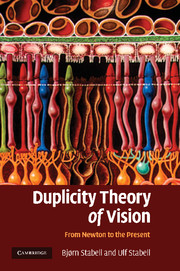Book contents
- Frontmatter
- Contents
- Acknowledgements
- 1 Introduction
- Part I The development of the basic ideas of the duplicity theory from Newton to G. E. Müller
- Part II The development of the duplicity theory from 1930–1966
- Part III Chromatic rod vision: a historical account
- Part IV Theories of sensitivity regulation of the rod and cone systems: a historical account
- Part V Factors that triggered the paradigm shifts in the development of the duplicity theory
- References
- Index
1 - Introduction
Published online by Cambridge University Press: 22 January 2010
- Frontmatter
- Contents
- Acknowledgements
- 1 Introduction
- Part I The development of the basic ideas of the duplicity theory from Newton to G. E. Müller
- Part II The development of the duplicity theory from 1930–1966
- Part III Chromatic rod vision: a historical account
- Part IV Theories of sensitivity regulation of the rod and cone systems: a historical account
- Part V Factors that triggered the paradigm shifts in the development of the duplicity theory
- References
- Index
Summary
ROOTS OF THE DUPLICITY THEORY OF VISION: ANCIENT GREEKS
The duplicity theory is the most basic and comprehensive theory within vision research. Yet, there has been no attempt to describe its developmental history. In the present work, therefore, our aim has been to throw some light on this dark area in the history of science. As will be seen, the duplicity theory is not an old, static, antiquated theory dating back to Schultze's (1866) original formulation of the theory, as is generally held, but is a living body that expands and deepens as new knowledge of the rod and cone systems is obtained.
The beginning of the scientific study of vision may be traced back to the Ancient Greeks. However, due to an almost complete lack of knowledge about optics and sensory information processing at that time, the Greeks made two serious mistakes in their functional interpretation of the visual system. Thus, they generally held that (1) the crystalline lens of the eye was the most important organ of vision, being the actual sense organ, and (2) visual perception depended in a fundamental way on some sort of ‘rays’ that emanated from the lens toward the objects of the environment.
Both assumptions were accepted and adhered to in one form or other by many of the leading Ancient Greek philosophers and research workers. The most important among them, because of his strong and long-lasting influence on science in Western Europe, was Galen – also named Galenos (about AD 130–200).
- Type
- Chapter
- Information
- Duplicity Theory of VisionFrom Newton to the Present, pp. 1 - 5Publisher: Cambridge University PressPrint publication year: 2009



